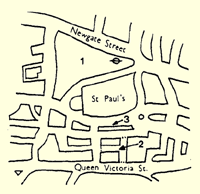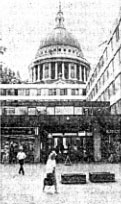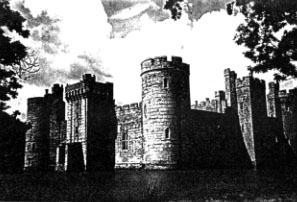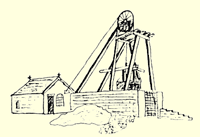
Travels with the TardisThis article is the first in a series of reports on past Doctor Who locations. Most attempts at this by other publications have failed, because (a) they don't go into enough detail, and (b) they don't tell the reader how to find the place. Either of these could be (and often is) a result of the researcher not actually finding the locations. I hope to eliminate these problems in this series, since I have recently visited every site discussed. By actually tracking down these places, I know the problems encountered in finding a location, and can provide detailed maps to ensure that others will not get lost. In addition, we can publish photographs of "Doctor Who" material with no problems of copyright, for the simple reason that I have taken the pictures myself! To start off the series, I am featuring St Paul's Cathedral (as seen in The Invasion), Bodiam Castle (site of all outdoor material in The King's Demons), and Busts Hill Open Air Museum (Mark of the Rani). The choice of St Paul's may seem a strange one, as almost everybody must have seen the famous photograph of the Cybermen marching down the steps in front of the Cathedral, and St Paul's itself is not all that difficult to find. However, if you have ever tried to find those steps, you may well have spent a long time looking, and even concluded that they no longer exist.
After that brief glimpse into the past, you should come out in front of the Cathedral itself. Skirt around the outside, or spend a while exploring inside, but you should make your way to the south side eventually. If you see a small information centre on an island in the road (3 on the map), you should be on the right track - if not, you could alwaysask your way at the information centre. ("An example of recursion if we had an information centre, we could look it up in the information centre".) After that it's a simple matter to find Peters Hill, to the south. (Although not very clear on the map, Peters Hill is the north-south road off Queen Victoria street.) Continue along Peters Hill, and when you fall down two flights of steps, you've found it.
If this description leaves you thinking that the steps are difficult to find, then that's because they are difficult to find. The first time we went looking for them, we went round and round Paternoster square, and came away believing that they had been demolished in a redevelopment scheme. If, however, this description leaves you thinking how easy it should be to find such a famous landmark, then you'd also be right. The second time we tried to find the location (having discovered that the steps do still exist), It was only a matter of minutes before we stumbled upon them. Having said that, it should be even easier for you to find them, after all, where else have you seen such a thorough guide to a few steps? "That's all very well," I hear you cry (says he using artistic licence), "but what if I can't be bothered to trek all the way down to London just to see some old steps?" Fair comment. If you're so stingy that your bank balance comes before Doctor Who, then you'll have to lust take my word for it when I say that the steps are quite an experience. This is one Doctor Who location which Is immediately recognisable as such, and I think it is this, combined with the visual impact of the sweeping approach to the Cathedral, that evokes such feeling in any fan who takes the trouble to visit It. Take a camera with you. Better still, take some idiots (friends, relatives, local group members etc) with you and have fun posing as Cybermen on the steps like typical Doctor Who fans. (Typical? You must be joking.)
However, if St Pauls isn't your idea of a nice day out, you could always try a complete change of scenery with Bodiam Castle in Sussex. The village of Bodiam lies off the A229, between Hastings and Maidstone (OS map 199) and the sketch map (not online) should help you to find the castle itself. If Sussex is a long way from where you live, and, like us, you feel that hotels are too expensive, you may like to try the campsite we found to the west of the A229 (marked on the sketch map). This site was reasonable for an overnight stop (although the toilets provided could do with some improvement) and it boasts a one mile riverside walk to the castle, which we didn't try. If you want to use it, the map reference is 767244 and the owners are: G & R Bailey, Park Camp, Park Farm, Bodiam (telephone Staplecross 514). 1 would recommend getting in touch first to check availability of pitches, etc. When you visit the castle, your first reaction might be to say that The King's Demons couldn't have been filmed there. This castle has a large, water-filled moat, which certainly wasn't present in Fitzwiiliam Castle! Not being an expert on history, I can't say whether Thirteenth Century castles had moats or not, but perhaps this is why the moat was not seen on television. Alternatively, by showing the moat, perhaps some other, contempory, feature would have been visible (such as the new wooden bridge across the water). Either way, the BBC chose their camera angles very carefully, and it's not until you see Bodiam Castle that you appreciate what a excellent job they did. As with all Doctor Who locations you visit, it's a good idea before you go to have a look at any photos from that story, and a video recording If you have one. That way, when you come to look around the site, it is much easier to see where particular events occurred. For instance, after the initial scene, The King's Demons features a few establishing shots, and then an extensive jousting scene. Using a video it can be seen that this was filmed mainly on an area of grass to the south of the castle (2 on the map - still to be scanned in). From this point, though, very little of the castle itself can be seen through the trees. Presumably because of this, a few scenes (particularly clos~ups of the riders) are filmed to the south-east, giving a clear view of the castle in the background (1). After the Doctor's arrival, the action cuts to the interior of the castle, without showing the journey there. This conveys quite well the impression that the castle is near, even though the entrance (shown later) is to the north. As previously stated, the bridge over the moat is not shown, with the scenes showing the entrance being filmed from a low angle. This appears to have been achieved by mounting the camera close to the ground, right up against the edge of the bridge (3). Unfortunately, due to the fact that The King's Demons was only two episodes long, little else is seen of Bodlam Castle. In particular, great work was put into preparing the central courtyard for filming, yet this only featured In the background in a few scenes. (If you look carefully during the story, you can catch a glimpse, through the entrance, of costumed extras going about their business.) The only other location filming in the story occurred with the horseback scenes In the woods. These probably took place amongst the trees to the north-east or to the west. One point to remember if you visit Bodiam is that The King's Demons was filmed in winter. If you see it in the height of summer, it loses some of the barren atmosphere present In the Thirteenth Century Fitzwilliam Castle. However, the castle is not open on Sundays in the winter, and not at all over the Christmas period. Besides, even if it does lose its atmosphere, castles are much more pleasant to visit in the summer. My final topic for this issue is the Blists Hill Open Air Museum, part of the Ironbridge Gorge Museum, near Telford. Unlike St Paul's Cathedral and, to a certain extent, Bodiam Castle, this Is suitable for a complete day out, and will provide enjoyment for all the members of your party, whether they are interested in Doctor Who or not. The Ironbridge Gorge Museum Trust was set up in 1967, and now the entire complex covers about forty-two acres. The area you want Is Busts Hill, just to the north of Coalport, and is about four miles south of Telford. I won't attempt to give detailed instructions on finding it, as the site may be approached from so many different directions, but if you take the AS to Teiford and follow the sIgns, you shouldn't go too wrong.
just beyond the pit-head is the start of the Shropshire Canal. It was into here that the Doctor almost fell in episode two (5) and some establishing shots of the mine were filmed from the other side of the canal, for episode one. Moving back to the High Street, the Saw Mill and Woodworking Shop (2) was probably where the pit office was set. All views of this were shot at close quarters, so that its real location was not revealed. Similarly for the bath-house, which was actually the Candle Factory in the museum (3). Whenever this appeared, it was filmed so as to disguise the fact that it was only a few feet away from the pit-head. Before I go any further, I should like to point out that the map provided is only a sketch map, and the vertical scale has been compressed in places in order to fit it all in! Having said that, the round trip (down the left of the map, up the inclined plane (8), and back along the canal) is not too far for the average person, and well worth the effort (even if you're not a Doctor Who fan). Incidentally, Peri must be exceptionally fit, for at the end of episode one we saw her give the Doctor a small push on his trolley outside the bath-house (3). Then, seconds later, he can be seen flying along a path, where he is intercepted by a group of workers who re-direct him towards another pit-head (6)! The Doctor must also have very good eyesight if the Rani expected him to see the TARDIS disappearing down this same mine shaft a distance of a mile or so from the bath-house! It really is amazing what they can do with a few camera tricks.
Further along the same path is the last recognisable Doctor Who item at the Busts Hill Museum. This is the entrance to the "adit" mine where the Rani's TARDIS was hIdden (7 on the map, and illustration below right), Like many of the exhibits at Busts Hill, this is a replica, built in 1970. On close examination, it can be seen that the tunnel extends only a little way into the side of the hill, but otherwise it appears to stretch on for a long way. All scenes inside the tunnel were, of course, shot in the studio. The only remaining scenes that may have been filmed here are those in the woods. There is plenty of woodland at Ironbridge, but at least one scene was filmed elsewhere (if Travel Without The Tardis is to be believed - personally I wouldn't trust it as far as I could throw It - and I've had plenty of occasions when I've wanted to throw it, tear it up into small pieces, burn it, jump on it, feed it to the cat and .... sorry I think I was getting a bit carried away there). That just about wraps it up for this issue's Travels with the Tardis. Next issue I hope to feature, amongst other things, Trent Park (from Mawdryn Undead), perhaps Black Park (various stories) and other locations in London. |
 In fact they do still exist, but
the task of locating them is not made easier by the existence of a "new"
shopping centre, Paternoster square, to the north of the Cathedral (see picture below and
1 on the map). This looks very similar in style of architecture to the buildings flanking
the famous steps. The site, however, is actually to the south of St Paul's, in Peters
Hill, just off Queen Victoria Street (2 on the map). If you intend to visit the street
yourself, the easiest way is probably to take the underground to St Paul's, on the Central
line, and you should emerge on the south side of Newgate Street. From there you may want
to walk through Paternoster square, and marvel at the typical sixties architecture. For
those of you who are not so keen on this style of building, you may be pleased to hear
that the square is to be "redeveloped" (knocked down).
In fact they do still exist, but
the task of locating them is not made easier by the existence of a "new"
shopping centre, Paternoster square, to the north of the Cathedral (see picture below and
1 on the map). This looks very similar in style of architecture to the buildings flanking
the famous steps. The site, however, is actually to the south of St Paul's, in Peters
Hill, just off Queen Victoria Street (2 on the map). If you intend to visit the street
yourself, the easiest way is probably to take the underground to St Paul's, on the Central
line, and you should emerge on the south side of Newgate Street. From there you may want
to walk through Paternoster square, and marvel at the typical sixties architecture. For
those of you who are not so keen on this style of building, you may be pleased to hear
that the square is to be "redeveloped" (knocked down).

 On entering the
museum, you may well be offered a guide to the exhibits. if your interests extend no
further than Doctor Who, then don't bother with one. The sketch map (over the page) is
based upon the various maps in the guide book, and all the places mentioned in this report
should present no difficulty In identlfication. If, however, you have come to Ironbridge
for a good day out, then the guide is very useful.As you move down the High Street from
the entrance, there are many exhibits not seen in The Mark of the Rani. On the right, you
will pass the Railway Siding, the Sweet Shop, the Blacksmith's, the Cobbler's, the
Builder's Yard and the Plasterer's Shop. On the left is the Bank, the Chemist's Shop, the
New Inn, the Butcher's, the Slaughterhouse, the Printing Shop, the Locksmith's Shop and
the Foundry. Only once you have passed these do you get onto the serious business of
identifying Doctor Who locations. Following the road to the (illegible text), in
front of you is where the pit scenes were filmed. The gates to the mine are not there,
presumably being BBC props, but they can be readily visualised across the road (1 on the
map). The mine workings, though, can be seen in this area (see illustration above, and 4
on the map). The shaft here is the original, but the winding house and headgear are
reconstructions, built in the seventies. The engine is operational, with demonstrations
given on request. It is interesting to note that when the Sixth Doctor was seen hanging
from the pit-shaft chain, it was above this shaft. Presumably adequate safety precautIons
were used, since Colin Baker really was above a 600 foot drop.
On entering the
museum, you may well be offered a guide to the exhibits. if your interests extend no
further than Doctor Who, then don't bother with one. The sketch map (over the page) is
based upon the various maps in the guide book, and all the places mentioned in this report
should present no difficulty In identlfication. If, however, you have come to Ironbridge
for a good day out, then the guide is very useful.As you move down the High Street from
the entrance, there are many exhibits not seen in The Mark of the Rani. On the right, you
will pass the Railway Siding, the Sweet Shop, the Blacksmith's, the Cobbler's, the
Builder's Yard and the Plasterer's Shop. On the left is the Bank, the Chemist's Shop, the
New Inn, the Butcher's, the Slaughterhouse, the Printing Shop, the Locksmith's Shop and
the Foundry. Only once you have passed these do you get onto the serious business of
identifying Doctor Who locations. Following the road to the (illegible text), in
front of you is where the pit scenes were filmed. The gates to the mine are not there,
presumably being BBC props, but they can be readily visualised across the road (1 on the
map). The mine workings, though, can be seen in this area (see illustration above, and 4
on the map). The shaft here is the original, but the winding house and headgear are
reconstructions, built in the seventies. The engine is operational, with demonstrations
given on request. It is interesting to note that when the Sixth Doctor was seen hanging
from the pit-shaft chain, it was above this shaft. Presumably adequate safety precautIons
were used, since Colin Baker really was above a 600 foot drop. Unlike the previous stunt, this
one was not nearly so dangerous. This mine shaft (6 - see illustration right) is a
replica, with a shaft depth of only a few feet. This type of wooden headgear was
originally used with horses operating a winding drum, and the shallow trolley was pushed
beneath the basket of coal raised from the mine - thus avoiding deaths by pit workers
falling down the shaft. This is very similar to the use it was put to In Mark of the Rani.
Unlike the previous stunt, this
one was not nearly so dangerous. This mine shaft (6 - see illustration right) is a
replica, with a shaft depth of only a few feet. This type of wooden headgear was
originally used with horses operating a winding drum, and the shallow trolley was pushed
beneath the basket of coal raised from the mine - thus avoiding deaths by pit workers
falling down the shaft. This is very similar to the use it was put to In Mark of the Rani.